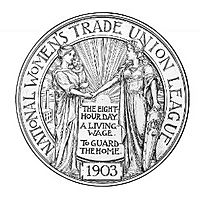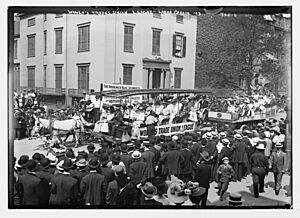Women's Trade Union League facts for kids
 |
|
| Founded | 1903 |
|---|---|
| Dissolved | 1950 |
| Location | |
|
Key people
|
Margaret Dreier Robins, President |
|
Parent organization
|
American Federation of Labor |
The Women's Trade Union League (WTUL) was an important group in the United States from 1903 to 1950. It brought together women from all walks of life. Their main goal was to help women workers form unions. Unions are groups that protect workers' rights. The WTUL also wanted to stop unfair and unsafe working conditions, often called sweatshops.
They played a big part in major strikes in the early 1900s. These strikes helped create important unions. Examples include the International Ladies' Garment Workers' Union. The WTUL also worked hard to get women's suffrage. This means the right for women to vote.
How the WTUL Started
The idea for the WTUL came from a similar group in Britain. That British group started about 30 years earlier. It helped women's unions and worked with the main labor movement there.
In 1902, an American socialist named William English Walling met with leaders of the British group. He returned to the U.S. and started gathering support. He wanted to create a similar organization in America.
The WTUL officially began in 1903. This happened at a big meeting of the American Federation of Labor (AFL). The AFL was a large group of unions. The WTUL wanted to work closely with the AFL.
Its first president was Mary Morton Kehew. She was a reformer from Boston. By 1907, the WTUL focused on helping women join unions that were part of the AFL.
The WTUL also got ideas from the settlement house movement. People like Jane Addams and Florence Kelley were part of this. They helped poor communities. The WTUL leaders included both wealthy women who wanted to help and working-class women. These working-class women had experience organizing unions. Important leaders included Mary Kenney O'Sullivan and Rose Schneiderman.
The WTUL was most active between 1907 and 1922. During this time, Margaret Dreier Robins was its president. The WTUL worked to organize women into unions. They also pushed for laws to protect workers. And they taught the public about the challenges faced by working women.
Helping Workers Form Unions
The WTUL supported many strikes. A strike is when workers stop working to demand better conditions. For example, they helped with a telegraphers' strike in 1907.
They played a huge role in the "Uprising of the 20,000" in 1909. This was a strike by shirtwaist workers in New York City and Philadelphia. Most of these workers were women. The WTUL provided a place for the strikers to meet. They raised money for food and to pay bail for arrested picketers. Picketers are people who stand outside a workplace to protest.
WTUL members, including wealthy women, joined the picket lines. Some people jokingly called them the "mink brigade" because of their fancy clothes. The WTUL also helped publicize the workers' demands. They wanted better pay and an end to sweatshop conditions.
This strike helped workers gain some improvements. It also taught the WTUL and women garment workers a lot about organizing.
The WTUL also helped with other strikes. These included strikes by cloakmakers in New York City in 1910. They also supported garment workers in Cleveland in 1911.
Over time, the WTUL sometimes disagreed with the male leaders of some unions. They felt these leaders did not always represent women workers well. The WTUL also had a strong connection with the Amalgamated Clothing Workers of America union. This union was not part of the AFL.
In 1914, the WTUL started a school in Chicago. It trained women to become labor leaders and organizers. They were key in helping Italian garment workers join unions in New York.
Pushing for New Laws
The WTUL also started working for new laws. They wanted an eight-hour day for workers. This meant workers would only work eight hours a day. They also pushed for a minimum wage. This is the lowest amount an employer can pay workers. They also wanted "protective legislation." These were laws designed to keep women and children safe at work.
At the time, the U.S. Supreme Court often struck down laws that tried to control businesses. But laws that specifically protected women and children were sometimes allowed.
The WTUL was very active in demanding safe working conditions. This was especially true after the Triangle Shirtwaist Factory fire in 1911. In that terrible fire, 146 workers died. This event made many people realize how dangerous factories could be.
The fire also showed some differences within the WTUL. Some working-class leaders, like Rose Schneiderman, felt that workers had to fight for themselves. She famously said: "Too much blood has been spilled. I know from my experience it is up to the working people to save themselves. The only way they can save themselves is by a strong working-class movement."
The WTUL also worked hard for women's suffrage. They joined forces with the National American Woman Suffrage Association. They believed that if women could vote, they could pass laws to protect themselves. They also felt voting would give women more respect and equality.
In 1912, Rose Schneiderman used a famous phrase while campaigning for voting rights. She said: "The worker must have bread, but she must have roses, too." This meant that workers needed basic necessities ("bread") but also beauty, dignity, and joy ("roses"). Her phrase "We want bread and roses too" became a famous slogan for workers' rights.
The WTUL did not agree with another group, the National Woman's Party. The National Woman's Party wanted an Equal Rights Amendment. The WTUL worried this amendment would get rid of the protective laws they had fought so hard to win for women.
In the 1920s and later, the WTUL focused even more on passing laws. Many of its leaders supported the New Deal. This was a series of programs by President Franklin D. Roosevelt to help the country during the Great Depression. Eleanor Roosevelt, the President's wife, was a member of the WTUL. The WTUL officially closed down in 1950.


